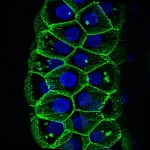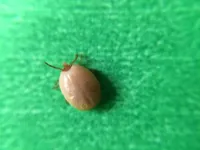(Press-News.org) In one of the first large-scale studies of genes related to diet, researchers have uncovered almost 500 genes that appear to directly influence the foods we eat. The findings represent an important step toward using a person’s genetics to develop precision nutrition strategies that help improve health or prevent disease.
“Some genes we identified are related to sensory pathways — including those for taste, smell, and texture — and may also increase the reward response in the brain,” said research team leader Joanne Cole, PhD, assistant professor in the Department of Biomedical Informatics at the University of Colorado School of Medicine. “Because some of these genes may have clear paths toward influencing whether someone likes a food or not, they could potentially be used to create sensory genetic profiles for fine-tuning a person’s dietary recommendations based on foods they like to eat.”
For the study, the researchers used the UK Biobank, which contains data from 500,000 people, to perform a phenome-wide association study (PheWAS) that identified genes more strongly associated with diet than with any health or lifestyle factor. PheWAS studies are used to find associations between gene variants of interest and a spectrum of human traits and behaviors, including dietary intake.
“The foods we choose to eat are largely influenced by environmental factors such as our culture, socioeconomic status, and food accessibility,” said Cole. “Because genetics plays a much smaller role in influencing dietary intake than all the environmental factors, we need to study hundreds of thousands of individuals to detect genetic influences amid the environmental factors. The data necessary to do this hasn’t been available until recently.”
Cole will present the findings at NUTRITION 2023, the annual flagship meeting of the American Society for Nutrition held July 22-25 in Boston.
One challenge in identifying diet-related genes is that what people eat correlates with many other factors, including health factors such as high cholesterol or body weight and even socioeconomic status. In the new work, the researchers applied computational methods to tease out direct effects of genetic variants impacting diet and separate those from indirect effects such as ones where a gene impacts diabetes and having diabetes requires a person to eat less sugar.
This study design was possible because the UK Biobank not only contains in-depth genetic information but also detailed health and socioeconomic data. This allowed the researchers to test individual genetic variants for associations with thousands of traits and then eliminate indirect gene variants that were more strongly associated with other factors, such as diabetes.
The analysis revealed around 300 genes directly associated with eating specific foods and almost 200 genes linked to dietary patterns which group various foods together — for example, overall fish intake or fruit consumption.
“The study showed that dietary patterns tend to have more indirect genetic effects, meaning they were correlated with a lot of other factors,” said Cole. “This shows how important it is to not study dietary patterns in a vacuum, because the eating pattern’s impact on human health may be completely mediated or confounded by other factors.”
In the short term, Cole is studying the newly identified diet-related genes to better understand their function while also working to identify even more genes that directly influence food preferences. She would like to pursue several lines of translational research based on these findings. For example, she is interested in studying whether using a person’s genetics to adapt the flavor profile of a diet designed for weight loss could improve adherence.
It might also be possible to use these new insights to tailor foods to a person's genetic predisposition. “If we know that a gene encoding an olfactory receptor in the nose increases a person’s liking of fruit and boosts the reward response in the brain, then molecular studies of this receptor could be used to identify natural or synthetic compounds that bind to it,” Cole said. “Then, we could see if adding one of those compounds to healthy foods makes those foods more appealing to that person.”
Cole will present this research at 2:55 p.m. on Saturday, July 22, during the Personalizing Nutrition - Genetics and Dietary Pattern Interactions Poster Theater Flash Session in the Sheraton Boston, Fairfax (abstract; presentation details).
Please note that abstracts presented at NUTRITION 2023 were evaluated and selected by a committee of experts but have not generally undergone the same peer review process required for publication in a scientific journal. As such, the findings presented should be considered preliminary until a peer-reviewed publication is available.
About NUTRITION 2023
NUTRITION 2023 is the flagship meeting of the American Society for Nutrition and the premier educational event for nutritional professionals around the globe. NUTRITION brings together lab scientists, practicing clinicians, population health researchers, and community intervention investigators to identify solutions to today’s greatest nutrition challenges. Our audience also includes rising leaders in the field – undergraduate, graduate, and medical students. NUTRITION 2023 will be held July 22-25, 2023 in Boston. https://nutrition.org/N23 #Nutrition2023
About the American Society for Nutrition (ASN)
ASN is the preeminent professional organization for nutrition scientists and clinicians around the world. Founded in 1928, the society brings together the top nutrition researchers, medical practitioners, policy makers and industry leaders to advance our knowledge and application of nutrition. ASN publishes four peer-reviewed journals and provides education and professional development opportunities to advance nutrition research, practice, and education. Since 2018, the American Society of Nutrition has presented NUTRITION, the leading global annual meeting for nutrition professionals.
Find more news briefs and tipsheets at: https://www.eurekalert.org/newsroom/nutrition2023.
###
END
There is growing evidence that consuming prebiotics — certain types of fiber often found in plants that stimulate beneficial bacteria in your gut — can help to maintain a healthy gut microbiome. In a new study, scientists estimated the prebiotic content of thousands of food types by using preexisting literature to find out which foods offer the highest prebiotic content.
According to the study, foods that pack the greatest prebiotic punch are dandelion greens, Jerusalem artichokes, garlic, leeks, and onions. In addition to supporting gut microbes, prebiotic rich ...
A University of Texas at Arlington engineering researcher is working on defenses that could thwart cyberattacks against networks of self-driving cars and unmanned aerial vehicles.
Animesh Chakravarthy, associate professor in the Department of Mechanical and Aerospace Engineering (MAE), is the principal investigator on an approximately $800,000 U.S. Department of Defense grant titled “Resilient Multi-Vehicle Networks.” MAE Professor Kamesh Subbarao, and Bill Beksi, assistant professor ...
Using electrochemistry to separate different particles within a solution (also known as electrochemical separation) is an energy-efficient strategy for environmental and water remediation: the process of purifying contaminated water. But while electrochemistry uses less energy than other, similar methods, the electric energy is largely derived from nonrenewable sources like fossil fuels.
Chemists at the University of Illinois Urbana-Champaign have demonstrated that water remediation can be powered in part — and ...
Millions of deaths and ongoing illnesses caused by the COVID-19 pandemic have prompted scientists to seek new ways of understanding how viruses so skillfully enter and reprogram human cells. Urgent innovations leading to the development of new therapies are needed since virologists predict that future deadly viruses and pandemics may again emerge from the coronavirus family.
One approach to developing new treatments for such coronaviruses, including the SARS-CoV-2 virus that causes COVID-19, is to block the mechanisms by which the virus reprograms our cells and forces them to produce more viral particles. But studies have identified nearly 1,000 human proteins ...
The worms that cause schistosomiasis (Schistosoma mansoni) are unusual in several ways, especially the fact that male and female adults must stay paired together throughout their lives for reproduction to be successful. Females may produce as many as 3,000 eggs per day. Approximately half reach the host’s gut or bladder. The rest are swept away via the blood to the liver and spleen, where they cause severe inflammation and liver cirrhosis, the main cause of mortality.
Researchers at Butantan Institute ...
Researchers have identified a number of chokepoints in U.S. agricultural and food supply chains through a study that improves our understanding of agri-food supply chain security and may aid policies aimed at enhancing its resilience. The work is presented in a paper published in the July 20, 2023, issue of the journal Nature Food, “Structural chokepoints determine the resilience of agri-food supply chains in the United States,” by authors including CEE Associate Professor Megan Konar and CEE Ph.D. student Deniz Berfin Karakoc.
The agricultural and food ...
The Spallation Neutron Source at the Department of Energy's Oak Ridge National Laboratory set a world record when its particle accelerator beam operating power reached 1.7 megawatts, substantially improving on the facility’s original design capability.
The accelerator’s higher power provides more neutrons for researchers who use the facility to study and improve a wide range of materials for more efficient solar panels, longer–lasting batteries and stronger, lighter materials for transportation. The achievement marks a new operational milestone for ...
The National Institute of Allergy and Infectious Diseases (NIAID), part of the National Institutes of Health, has awarded five projects for research to better understand Post-treatment Lyme Disease Syndrome (PTLDS), which is a collection of symptoms, such as pain, fatigue, and difficulty thinking or “brain fog,” which linger following standard treatment for Lyme disease. The Centers for Disease Control and Prevention estimates that 476,000 people in the United States are infected with Lyme disease each year. Between 10 and 20% of ...
WASHINGTON—The Endocrine Society opposes severe funding cuts proposed in the House Labor, Health and Human Services, Education, and Related Agencies (Labor-HHS) funding bill that would put life-saving endocrine research, disease prevention, and treatment at risk.
The House Appropriations Committee is planning to mark up the Labor-HHS funding bill before Congress leaves for its August recess.
The proposed funding levels in the Labor-HHS bill would harm America’s public health infrastructure and restrict research investments needed to develop next-generation cures. Cutting funding will reduce or eliminate services ...
ROCHESTER, Minn. — In a pilot study of 165 people, Mayo Clinic researchers looked at the effectiveness of two different approaches to weight loss: a standard lifestyle intervention and individualized therapy. The standard lifestyle intervention included a reduced diet, exercise and behavior therapy. The individualized approach was based on phenotypes and included different interventions depending on the person's predominant underlying cause of obesity. A diet based on phenotypes considers a person's ...




